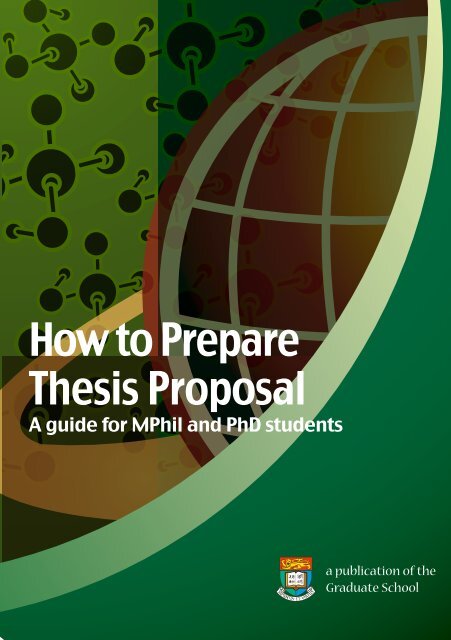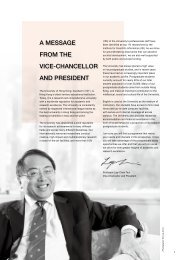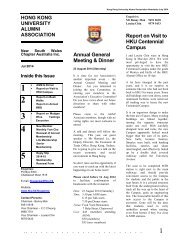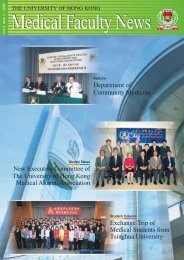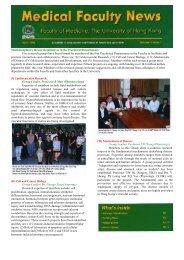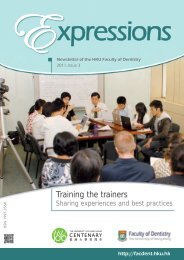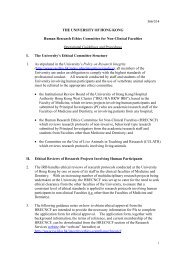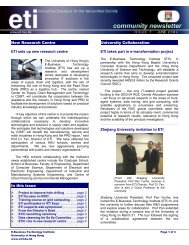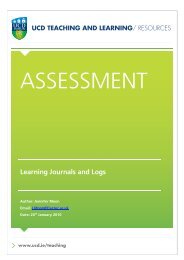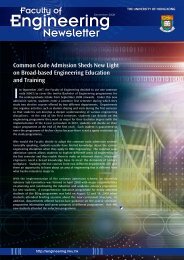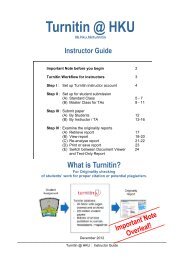Thesis Proposal How to Prepare - The University of Hong Kong
Thesis Proposal How to Prepare - The University of Hong Kong
Thesis Proposal How to Prepare - The University of Hong Kong
Create successful ePaper yourself
Turn your PDF publications into a flip-book with our unique Google optimized e-Paper software.
To many students, it may be the fi rst time that they write a research proposal. This booklet<br />
serves as a reference guide <strong>to</strong> highlight the process in preparing a research proposal and<br />
basic elements that should be included. Students should bear in mind that this booklet<br />
is in no way an exhaustive list <strong>of</strong> <strong>to</strong>pics that need <strong>to</strong> be considered in preparing a thesis<br />
proposal. Different disciplines may have different expectations and requirements on the<br />
substance, format and length <strong>of</strong> a proposal. In this regard, students are strongly advised<br />
<strong>to</strong> consult their supervisor(s) and the department beforehand.<br />
Graduate School<br />
March 2006<br />
Reprinted 2012<br />
Preface
Contents<br />
I. Introduction<br />
II. Preparation for a <strong><strong>The</strong>sis</strong> <strong>Proposal</strong><br />
III. Basic Elements <strong>of</strong> a <strong><strong>The</strong>sis</strong> <strong>Proposal</strong><br />
IV. Presentation and Language<br />
V. Further Readings<br />
Appendices<br />
1<br />
2<br />
4<br />
9<br />
14<br />
15<br />
I. Introduction<br />
All MPhil and PhD students in HKU are required <strong>to</strong> have their candidature confi rmed by<br />
the end <strong>of</strong> the probationary period. By the end <strong>of</strong> the probationary period, every student<br />
is required <strong>to</strong> submit a thesis proposal for consideration by the Departmental Research<br />
Postgraduate Committee (DRPC) and the Faculty Higher Degrees Committee (FHDC).<br />
<strong>The</strong> thesis proposal is one <strong>of</strong> the most important documents that the <strong>University</strong> will<br />
consider in determining whether the candidature <strong>of</strong> a student should be confi rmed or<br />
be terminated. It is also important <strong>to</strong> students as a plan for how the research should be<br />
implemented and <strong>to</strong> set a time schedule so that the thesis could be completed within the<br />
specifi ed time frame.<br />
Full-time Part-time<br />
Degree Probationary<br />
period<br />
Study period Probationary<br />
period<br />
Study period<br />
MPhil 12 months 24 months 18 months 36 months<br />
3-year PhD 12 months 36 months 18 months 54 months<br />
4-year PhD 18 months 48 months 24 months 72 months<br />
1
II. Preparation for a <strong><strong>The</strong>sis</strong> <strong>Proposal</strong><br />
Before writing the thesis proposal, a student should have already taken most <strong>of</strong> coursework<br />
and done an extensive literature review. He/she should have a solid understanding on the<br />
background materials and previous research done by other researchers in the same fi eld.<br />
Most importantly, he/she should have identifi ed a research <strong>to</strong>pic with his/her supervisor.<br />
In developing a research <strong>to</strong>pic, it is advisable <strong>to</strong> develop two <strong>to</strong> three <strong>to</strong>pics fi rst and then<br />
fi nally focus on a <strong>to</strong>pic <strong>to</strong> develop further. You may like <strong>to</strong> ask the following questions in<br />
deciding on a research <strong>to</strong>pic:<br />
- What is the contribution <strong>to</strong> knowledge in your fi eld <strong>of</strong> study?<br />
- Has it been done by others before?<br />
- What is the theoretical framework for the study?<br />
- What are the research hypotheses or questions?<br />
- Are data, if needed, available?<br />
- <strong>How</strong> <strong>to</strong> collect data?<br />
- What are the appropriate methods in analyzing the data?<br />
- What are the expected end results?<br />
- Can the thesis be done within the time period <strong>of</strong> study?<br />
Writing a thesis is the beginning <strong>of</strong> a scholarly work. You should write a thesis that<br />
you can manage within your present resource and time frame.<br />
Developing a research <strong>to</strong>pic and writing a proposal cannot be done within a week.<br />
You must allow yourself enough time <strong>to</strong> develop your research <strong>to</strong>pic and proposal<br />
well before the deadline. You need time for your library research and <strong>to</strong> make sure that<br />
you understand all the issues involved in your proposed research. You may also need<br />
time <strong>to</strong> learn about the particular research methodologies that you propose <strong>to</strong> use. You<br />
should consult your supervisor in the process and be open <strong>to</strong> any advice that he/she<br />
may be willing <strong>to</strong> give. It is helpful <strong>to</strong> look at some sample products, i.e. theses in your<br />
fi eld, before writing your proposal because at the end <strong>of</strong> the day, the fi nal product <strong>of</strong><br />
your thesis proposal is the thesis. You need <strong>to</strong> know what it roughly looks like before<br />
you can propose what <strong>to</strong> do in order <strong>to</strong> produce it. If possible, ask for copies <strong>of</strong> past<br />
theses that your supervisor has approved. Having a sample <strong>of</strong> a successful thesis can<br />
make the preparation <strong>of</strong> your own much easier.<br />
As your proposal will probably go through several drafts before you are ready <strong>to</strong> submit<br />
it, you should set aside each draft for a few days, or even a week, before attempting<br />
<strong>to</strong> revise it. This will give you some distance from the draft, enabling you <strong>to</strong> spot<br />
mistakes or gaps in logic that you simply could not see before. It also allows you time<br />
<strong>to</strong> show it <strong>to</strong> your supervisor <strong>to</strong> get his comments and advice. If you start preparing<br />
your proposal a few days before the deadline, the proposal will be rushed, and more<br />
likely will be fl awed.<br />
Do not take the thesis proposal lightly. A good thesis proposal is half-way <strong>to</strong> a good<br />
thesis. It will help you <strong>to</strong> focus on what you would like <strong>to</strong> do and plan <strong>to</strong> do in your<br />
research. It is also a refl ection <strong>of</strong> your knowledge <strong>of</strong> your fi eld <strong>of</strong> study and research<br />
methodology and how serious you are in doing research. A sloppy thesis proposal will<br />
not impress people who are examining it that you are ready for your research.<br />
In writing the research proposal, you should:<br />
- State the objectives and signifi cance <strong>of</strong> your research clearly<br />
- Show the contribution <strong>of</strong> your research in advancing the knowledge <strong>of</strong> your<br />
fi eld <strong>of</strong> study<br />
- Be focused on your research questions<br />
- Provide a sound theoretical framework <strong>of</strong> your study based on comprehensive<br />
literature review (after you have fi nished your thesis, you should be the<br />
expert and pioneer in your fi eld)<br />
- Make sure that you have cited the most important seminal work related <strong>to</strong><br />
your study<br />
- Avoid providing a long reference list which contains a lot <strong>of</strong> work which is<br />
marginal <strong>to</strong> your research<br />
- Provide a persuasive argument and justifi cation <strong>of</strong> your research<br />
- Provide a time schedule <strong>of</strong> your research and completion <strong>of</strong> the thesis<br />
- Indicate the likely end results <strong>of</strong> your research<br />
- Write clearly in good English<br />
2<br />
3
III. Basic Elements <strong>of</strong> a <strong><strong>The</strong>sis</strong> <strong>Proposal</strong><br />
<strong>The</strong> following <strong>to</strong>pics/chapters are the most commonly suggested elements <strong>of</strong> a thesis<br />
proposal. It is highly recommended that students should consult the supervisor(s) and<br />
the Department for the specifi c requirements in their own fi eld <strong>of</strong> study.<br />
1. Title Page<br />
(i) Tentative thesis title<br />
(ii) Your full-name<br />
(iii) Name <strong>of</strong> your supervisor<br />
(iv) Degree sought<br />
(v) Department <strong>of</strong> study<br />
(vi) Date <strong>of</strong> submission<br />
<strong>The</strong> thesis title should be concise, descriptive and fairly self-explana<strong>to</strong>ry. Choose a title<br />
that is easy <strong>to</strong> understand and represent the main theme <strong>of</strong> your thesis. For example, the<br />
phrase “An investigation <strong>of</strong> …” should be omitted and students could consider stating<br />
the title in terms <strong>of</strong> a functional relationship so as <strong>to</strong> clearly indicate the independent and<br />
dependent variables.<br />
A sample title page is given at Appendix II.<br />
2. Abstract <strong>of</strong> <strong><strong>The</strong>sis</strong> <strong>Proposal</strong><br />
<strong>The</strong> abstract is a summary <strong>of</strong> your thesis proposal. It is usually not more than 1 or 2<br />
pages containing the problem statement, the rationale <strong>of</strong> the study, the hypothesis, the<br />
methodology that you are proposing <strong>to</strong> use, the expected result and the signifi cance <strong>of</strong><br />
your study. This section gives the reader an overview <strong>of</strong> your thesis proposal. Don’t<br />
try <strong>to</strong> explain the technical details or methodology <strong>of</strong> your study here, as these should<br />
be included in the latter sections. Try <strong>to</strong> present your idea in layman language so that<br />
even readers who are not in your fi eld could understand. This section should not contain<br />
references.<br />
3. Table <strong>of</strong> Contents<br />
You should list all headings and subheadings with page numbers. Subheadings should<br />
be indented.<br />
4. Introduction<br />
This section sets the context for your proposed project and must capture the reader’s<br />
interest. You should explain the background <strong>of</strong> your study starting from a broad picture<br />
narrowing in on your research questions, listing the relevant references, as appropriate.<br />
<strong>The</strong> introduction should be at a level that makes it easy <strong>to</strong> understand for readers with a<br />
general background in your fi eld.<br />
5. Literature Review<br />
<strong>The</strong> section demonstrates that you are knowledgeable <strong>of</strong> the primary texts and secondary<br />
research studies done by other researchers and ensure that you are not “reinventing the<br />
wheel”. It is important <strong>to</strong> note that this section is not merely a summary <strong>of</strong> the relevant<br />
literature you have read but instead, you have <strong>to</strong> provide a critical review on it and be able<br />
<strong>to</strong> relate the literature <strong>to</strong> your proposed research. You should point <strong>to</strong> areas overlooked<br />
or inadequately addressed by previous studies and discuss how your proposed research<br />
could contribute <strong>to</strong> the knowledge advancement in the area. This shows your ability <strong>to</strong><br />
integrate and synthesize the literature and <strong>to</strong> develop new ideas and innovations. Proper<br />
referencing in this section is very important.<br />
<strong>The</strong> followings are the most common defi ciencies <strong>of</strong> a literature review and you should<br />
try <strong>to</strong> avoid all <strong>of</strong> them:<br />
- lack <strong>of</strong> organization and structure<br />
- lack <strong>of</strong> focus and coherence<br />
- being repetitive<br />
- failing <strong>to</strong> cite infl uential papers or studies<br />
- citing irrelevant and trivial references<br />
- failing <strong>to</strong> cite the current papers or studies<br />
- failing <strong>to</strong> critically evaluate cited papers<br />
4<br />
5
6. Research Questions and Hypotheses<br />
This section tells reader what you would like <strong>to</strong> fi nd out in your research. State your<br />
research questions and hypotheses explicitly in this section. In most cases, the primary<br />
research question should be broad enough <strong>to</strong> cover your whole proposed research and the<br />
subsidiary research questions and hypotheses are more specifi c and each <strong>of</strong> them should<br />
focus on a certain aspect <strong>of</strong> your research. <strong>The</strong>se hypotheses usually form chapters or<br />
sub-sections <strong>of</strong> your fi nal thesis. You should explain how these research questions and<br />
hypotheses are formulated.<br />
7. Methodology<br />
This section explains “how” you are going <strong>to</strong> conduct your research. You should<br />
demonstrate that you are fully aware <strong>of</strong> the alternative research methods and explain<br />
how your proposed methodology is more advantageous than the others in attaining your<br />
stated objectives.<br />
For quantitative research, you should include:<br />
(i) the research design, e.g. a questionnaire study or a labora<strong>to</strong>ry experiment<br />
(ii) the subjects or data source, e.g. who will participate in the data collection, the<br />
sample size and sampling methodology<br />
(iii) the instruments, e.g. the kind <strong>of</strong> measuring instruments or questionnaires and<br />
the reason for choosing these instruments<br />
(iv) procedure, e.g. how you are going <strong>to</strong> carry out your study, what activities are<br />
involved and how long does it take<br />
(v) the methods <strong>of</strong> analysis, e.g. modeling techniques or statistical methods<br />
You should also discuss the limitations <strong>of</strong> the proposed methodology, the assumption and<br />
the range <strong>of</strong> validity in data collection.<br />
Where the thesis research involves human subjects, you must also obtain the approval<br />
from the appropriate ethics committee. A copy <strong>of</strong> the approval, if available, should be<br />
attached <strong>to</strong> the proposal.<br />
If you have conducted a pilot study, please also provide the details here and discuss how<br />
the methodology will be improved in view <strong>of</strong> the previous experience.<br />
For qualitative research, as there are no well-established and widely accepted general<br />
rules or principles, you need <strong>to</strong> elaborate more on the data collection process and how<br />
you will analyze the results.<br />
<strong>The</strong> methodology carries great weight <strong>to</strong> affect the success <strong>of</strong> a piece <strong>of</strong> research. You<br />
can have a very good research <strong>to</strong>pic but a poor research methodology could easily ruin<br />
the outcome! In order <strong>to</strong> prepare yourself for your research and <strong>to</strong> enable the reviewer<br />
<strong>to</strong> understand your proposed study better, you should be more detail in your research<br />
methodology. For example, how <strong>to</strong> collect your data, how many samples <strong>to</strong> take, what<br />
specifi c methods will you used in analyzing your data.<br />
8. Work Schedule<br />
Every student is supposed <strong>to</strong> submit the thesis for examination by the end <strong>of</strong> the study<br />
period, i.e. 2 years (full-time)/3 years (part-time) for MPhil; 3 years (full-time)/4.5 years<br />
(part-time) for 3-year PhD and 4 years (full-time)/6 years (part-time) for 4-year PhD.<br />
Hence, you should not start a research that could not be possibly completed within your<br />
study period.<br />
In this section, you need <strong>to</strong> identify the tasks and make realistic estimates <strong>of</strong> the time<br />
required for each task. This could be easily done in a table or chart format. Setting<br />
important miles<strong>to</strong>nes could defi nitely help <strong>to</strong> moni<strong>to</strong>r the research progress.<br />
9. Expected Results and Implication <strong>of</strong> Results<br />
Obviously you do not have results at the proposal stage. <strong>How</strong>ever, you need <strong>to</strong> have<br />
some idea about what kind <strong>of</strong> data you will be collecting, and what methods will be used<br />
in order <strong>to</strong> answer your research question or test your hypothesis. You should also state<br />
the contribution expected from your research efforts.<br />
66<br />
7
10. Tentative <strong><strong>The</strong>sis</strong> Chapter Outline<br />
You should check with your supervisor if this is a required section <strong>of</strong> the thesis proposal.<br />
Present the chapter outline as a draft contents page with brief annotations <strong>of</strong> expected<br />
content or stages will help you in thinking through the process and outcome <strong>of</strong> your<br />
research. Follow the standard sections relevant <strong>to</strong> your type <strong>of</strong> research. Look at past<br />
theses in your area and discuss your ideas with your supervisor.<br />
11. List <strong>of</strong> References<br />
This list is desirable only if the proposal contains six or more references. Otherwise, the<br />
references can be inserted in the text within parentheses, i.e.<br />
(Morita, Y [1996], Spring <strong>to</strong>rrents: <strong>The</strong> catastrophic effects <strong>of</strong> corn snow meltdown.<br />
European Ski Journal, 5, 141-162). (Note that brackets, not parentheses, are used within<br />
parentheses.)<br />
<strong>The</strong> style and format <strong>of</strong> the references depend on the disciplinary fi eld. <strong>The</strong> main<br />
consideration is consistency; whatever style is chosen should be followed scrupulously<br />
throughout. (Please see IV(1)(v) below.)<br />
1. Presentation<br />
IV. Presentation and Language<br />
8<br />
9<br />
(i) Fonts<br />
Even with access <strong>to</strong> all the power and variety that the combination <strong>of</strong> modern s<strong>of</strong>tware<br />
and hardware <strong>of</strong>fers, resist the temptation <strong>to</strong> use fancy or decorative fonts in the main<br />
part <strong>of</strong> the proposal. Look at any textbook, or a newspaper, and note that their body<br />
text is almost invariably printed in a serif font (a serif is a small cross stroke at the <strong>to</strong>ps<br />
and bot<strong>to</strong>ms <strong>of</strong> the main strokes <strong>of</strong> the letters, such as Roman, Times, Times Roman or<br />
Palatino). Sans serif (sans = without) fonts lack embellishments and are usually used<br />
only in titles, headings or other blocks <strong>of</strong> text, such as quotations, which need <strong>to</strong> be set<br />
apart from the main text.<br />
Use a standard font size (12 cpi). Small fonts are uncomfortable <strong>to</strong> read, while large ones<br />
are extremely distracting. Don’t try <strong>to</strong> use a small font in order <strong>to</strong> cram everything that<br />
you want <strong>to</strong> say in<strong>to</strong> specifi ed page limits.<br />
(ii) Sections and Headings<br />
To improve the layout <strong>of</strong> your proposal and make it easier <strong>to</strong> read, you can divide it in<strong>to</strong><br />
sections and sub-sections, each with a relevant heading. Use line spaces <strong>to</strong> separate the<br />
sections from one another, and bold, capitals or italics <strong>to</strong> highlight the headings.<br />
(iii) Point Form<br />
If you have <strong>to</strong> write a list <strong>of</strong> points/items, it may be a good idea <strong>to</strong> use point form. If your<br />
list consists <strong>of</strong> three items or fewer, you may as well write it sequentially, but for more<br />
than three, or if each point is quite long, point form is neater and easier <strong>to</strong> read. You can<br />
use bullets, asterisks, dashes, numbers or letters <strong>to</strong> introduce the points.
(iv) In-text Citations<br />
In a document as short as a research proposal, it is advisable <strong>to</strong> use a name-year (Smith,<br />
1994)* system and <strong>to</strong> structure the corresponding reference list alphabetically. This has<br />
at least two advantages. First, the reader may actually be familiar with the text(s) that<br />
you cite and will instantly know what you are referring <strong>to</strong> rather than having <strong>to</strong> take the<br />
time <strong>to</strong> fl ick back and forward <strong>to</strong> the reference list. Secondly, it will save you having<br />
<strong>to</strong> re-order numbers, and the numbers in the corresponding reference list, if you add<br />
further citations later. You may, however, prefer <strong>to</strong> use a number system, if that is what<br />
you are familiar with. <strong>The</strong>re are various different styles within both systems, and there is<br />
probably a preferred one in your fi eld. In the long run, it is immaterial which you use, as<br />
long as you are consistent.<br />
* Where there is more than one author, the citation should read (Smith & Jones, 1994),<br />
or (Smith et al., 1994), in the case <strong>of</strong> multiple authors.<br />
(v) Reference Lists<br />
Again, you will probably adopt the layout style that your department, faculty or discipline<br />
recommends, and, as before, consistency is important. For easier reading, it is helpful if<br />
you can leave a one-line space between each entry, highlight book/journal titles in some<br />
way, and bold your own name and those <strong>of</strong> your co-investiga<strong>to</strong>rs wherever they appear.<br />
For both references and citations, make sure that you read the relevant style manual<br />
thoroughly, double-checking all <strong>of</strong> your entries against it so that inconsistencies do not<br />
arise. Using reference list s<strong>of</strong>tware (such as Reference Manager) is also useful.<br />
Appendix II contains some examples <strong>of</strong> the issues that we have just covered on<br />
presentation.<br />
2. Language<br />
(i) Sentences<br />
In general, try <strong>to</strong> keep your sentences simple and short. It is not necessary for a piece <strong>of</strong><br />
writing <strong>to</strong> be “diffi cult” in order <strong>to</strong> be properly “academic”. To help keep your reader’s<br />
interest, it is certainly a good idea <strong>to</strong> vary sentence lengths throughout any piece <strong>of</strong><br />
writing, but overlong sentences invariably confuse the reader; they have <strong>to</strong> be read more<br />
than once, sometimes over and over, until they no longer make any sense. It never hurts<br />
<strong>to</strong> make your meaning quite clear: not everyone has the time <strong>to</strong> unravel long, unwieldy,<br />
jargon-fi lled sentences.<br />
(ii) Linking Devices<br />
Some conjunctions used <strong>to</strong> link ideas within and between sentences have become<br />
rather overused, particularly in an academic context. <strong>The</strong> most obvious are moreover,<br />
furthermore, hence and thus. It should almost always be possible <strong>to</strong> link sentences using<br />
a logical fl ow <strong>of</strong> ideas rather than conjunctions, but on the rare occasions that internal<br />
logic is not enough, the words ‘and’, ‘also’, ‘but’, ‘so’ and the occasional ‘therefore’,<br />
‘however’ or ‘although’ should be enough. Use others sparingly, if at all.<br />
(iii) Other Overused Words<br />
aforementioned paradigm notwithstanding<br />
above-mentioned parameter interpersonal<br />
(the) above ___ etc impact (used as a verb)<br />
(the) said ___ signifi cantly very<br />
viz prior <strong>to</strong> besides<br />
correlate indeed utilise<br />
respectively interrelated inherent<br />
Spend some time thinking <strong>of</strong> alternatives <strong>to</strong> these so that your writing does not become<br />
clichéd - and don’t use a thesaurus. <strong>The</strong>sauri usually list equally exotic alternatives,<br />
which will in their turn become overused. Stick <strong>to</strong> simple language.<br />
10<br />
11
(iv) Jargon<br />
Jargon is generally best kept <strong>to</strong> a minimum. If it becomes necessary <strong>to</strong> use a word that you<br />
think the reader might not understand, then you should give a brief explanation, either by<br />
supplying clues about the meaning <strong>of</strong> a word throughout the sentence, or by placing the<br />
defi nition in brackets or between commas or dashes after the word. It is easier <strong>to</strong> cut out<br />
unnecessary jargon if you avoid importing work from elsewhere - for example, from a<br />
lecture or journal article that you have written. Not only will it be obvious that you have<br />
done so (the style will differ from other parts <strong>of</strong> your proposal), but it will usually require<br />
substantial rewriting before it is suitable for your new audience - much more bother than<br />
writing it fresh in the fi rst place.<br />
(v) Variation and the Use <strong>of</strong> Pronouns<br />
A common problem in academic writing is a lack <strong>of</strong> variation, with writers using the same<br />
nouns over and over throughout a paragraph. This quickly becomes very mono<strong>to</strong>nous.<br />
Make good use <strong>of</strong> variants and pronouns <strong>to</strong> ensure that your writing is more interesting.<br />
Along the same lines, you may fi nd that there is some overlap in your answers <strong>to</strong> various<br />
questions. If this happens, refer the reader back/forwards <strong>to</strong> the relevant section rather<br />
than repeating the same sentences or paragraphs all over again. Even if you do have <strong>to</strong><br />
repeat information - in the abstract, for example - don’t use exactly the same words as<br />
before. It bores the reader and gives the impression that the writer is unimaginative.<br />
Paraphrase them instead.<br />
(vi) Spoken vs. Written Language<br />
Spoken, informal language is <strong>of</strong>ten inappropriately used in proposals, which should<br />
contain more formal writing. <strong>The</strong> most common examples <strong>of</strong> this are the words ‘get’,<br />
‘like’ (for making comparisons), and<br />
‘all’ (as in “all (<strong>of</strong>) the books”). Some Some synonyms<br />
for ‘get’, depending on the context, are: ‘obtain’, ‘gain’, ‘acquire’, ‘fi nd’. ‘For example’<br />
can <strong>of</strong>ten be used in place <strong>of</strong> ‘like’.<br />
(vii) Grammar<br />
Almost all <strong>of</strong> us, whether native English speakers or not, have problems with grammar at<br />
some time or another. In our haste <strong>to</strong> get our ideas down on paper, we are more concerned<br />
with content than form, and so we <strong>of</strong>ten make mistakes. Some mistakes are easily<br />
discovered during pro<strong>of</strong>reading, while others, particularly if you are not literary-minded,<br />
are not so easy either <strong>to</strong> spot or <strong>to</strong> remedy. If grammar is a problem for you - and you will<br />
usually know if this is the case - then you should be honest and try <strong>to</strong> do something about<br />
it rather than submitting a sub-standard piece <strong>of</strong> work. <strong>The</strong>re are some simple things you<br />
can do <strong>to</strong> help yourself:<br />
• Write short sentences, as recommended in Sentences, above. <strong>The</strong> longer a sentence<br />
is, the more complicated the grammar becomes, and the more likely it is that you<br />
will make mistakes.<br />
• Ask colleagues or friends <strong>to</strong> pro<strong>of</strong>read your work. This will help with grammar<br />
problems as well as any gaps in logic or unclearly-explained points. You know what<br />
you meant when you wrote something down, but part <strong>of</strong> the explanation may still<br />
be in your head and not on the paper! A good pro<strong>of</strong>reader will help sort this out.<br />
Alternatively, consult a pr<strong>of</strong>essional edi<strong>to</strong>r or pro<strong>of</strong>reader if you feel that you need<br />
more help than your colleagues can provide.<br />
(viii) Spelling<br />
Probably more than anything else, bad spelling irritates a literate reader. Often it is your<br />
typing rather than your spelling that is at fault, but whichever it is, if you do not correct<br />
mistakes, it looks as though you rushed your proposal, can’t be bothered <strong>to</strong> use a spellchecker<br />
or dictionary, and are therefore a sloppy worker - not a very good impression <strong>to</strong><br />
make on someone who is going <strong>to</strong> decide whether or not <strong>to</strong> confi rm your candidature.<br />
A word on American vs. British spelling: BE CONSISTENT in your use <strong>of</strong> the one that<br />
you choose. As it is likely, if you are not a native speaker <strong>of</strong> the one that you choose, that<br />
you will not be aware <strong>of</strong> the many differences between the two, it is crucial that you use<br />
the relevant spellchecker <strong>to</strong> help iron out any inconsistencies in your proposal.<br />
Please see Appendix III<br />
Appendix III for more detailed examples and further discussion <strong>of</strong> language<br />
matters.<br />
12<br />
13
V. Further Readings<br />
Cooley, Linda and Lewkowicz, Jo (2003), Dissertation Writing in Practice: Turning<br />
Ideas in<strong>to</strong> Text, <strong>Hong</strong> <strong>Kong</strong> : <strong>Hong</strong> <strong>Kong</strong> <strong>University</strong> Press.<br />
Cryer, Pat (2000), <strong>The</strong> Research Student’s Guide <strong>to</strong> Success, Buckingham: Open<br />
<strong>University</strong> Press.<br />
Day, Robert A. (1995), Scientifi c English, Westport: Oryx Press.<br />
Strunk, William, Jr. (2000), <strong>The</strong> Elements <strong>of</strong> Style, Bos<strong>to</strong>n: Allyn and Bacon.<br />
APPENDIX I - TITLE PAGE (SAMPLE)<br />
Your Tentative <strong><strong>The</strong>sis</strong> Title Here<br />
14<br />
15<br />
by<br />
Your Full-name<br />
Degree Sought<br />
Department <strong>of</strong> Study<br />
Name <strong>of</strong> your Supervisor<br />
Date <strong>of</strong> Submission
APPENDIX II - PRESENTATION (EXAMPLES)<br />
Use <strong>of</strong> Point Form<br />
<strong>The</strong> following sentence:<br />
Our objectives are <strong>to</strong> fi nd 1) a suitable format, 2) suffi cient transmission speed, and 3)<br />
minimum corruption <strong>of</strong> data.<br />
might have been more effectively presented as either:<br />
Our objectives are <strong>to</strong> fi nd:<br />
- a suitable format;<br />
- suffi cient transmission speed; and<br />
- minimum corruption <strong>of</strong> data.<br />
or:<br />
Our objectives are <strong>to</strong> fi nd a suitable format, suffi cient transmission speed, and minimum<br />
corruption <strong>of</strong> data.<br />
Reference List Layout<br />
Compare the following two extracts from reference lists, both roughly following the APA<br />
style:<br />
Bloggs, J and Hartley, J R (1995, December). <strong>How</strong> <strong>to</strong> write a better résumé. Job Hunting<br />
Quarterly Quarterly, Quarterly Quarterly, Quarterly 5 - 24.<br />
Geront, K R and Wong, Y L (1995). Résum ésum é é Basics (3rd ed). London: Little, Brown.<br />
Lemain, F (1992). Basic résumé construction. Eastern European RRésum<br />
ésum é é Journal, Journal , 64 64,<br />
157 - 206.<br />
This is much easier <strong>to</strong> read than:<br />
Bloggs, J and Hartley, J R (1995, December). <strong>How</strong> <strong>to</strong> write a better résumé. Job Hunting<br />
Quarterly, 5 - 24.<br />
Geront, K R and Wong, Y L (1995). Résumé Basics (3rd ed). London: Little, Brown.<br />
Lemain, F (1992). Basic résumé construction. Eastern European Résumé Journal, 64,<br />
157 - 206.<br />
Sentences<br />
APPENDIX III - LANGUAGE (EXAMPLES)<br />
Overlong sentences cause confusion. <strong>The</strong>y usually become <strong>to</strong>o long for one <strong>of</strong> two<br />
reasons:<br />
(i) using ten words where one will do, or<br />
(ii) trying <strong>to</strong> include <strong>to</strong>o many ideas.<br />
1. Here is an example <strong>of</strong> a sentence that uses <strong>to</strong>o many words:<br />
Since there is such a large variety <strong>of</strong> potential applications with industrial contributions<br />
that can be made, we need <strong>to</strong> identify a particular application that is both original,<br />
cost-effective and has a high potential for achievability within the time frame <strong>of</strong> this<br />
proposed project.<br />
(45 words)<br />
Looking at the highlighted phrases in order:<br />
(i) such a large variety : the word ‘large’ is essentially redundant;<br />
(ii) that can be made : <strong>to</strong>o many words;<br />
(iii) both : 3 things follow, so ‘both’ is incorrect. It is usually<br />
redundant anyway;<br />
(iv) cost-effective : a trendy buzz-word that usually simply means<br />
‘cheap’;<br />
(v) has a high potential... : ‘achievability’ has been invented by the author,<br />
and the whole phrase simply contains <strong>to</strong>o many<br />
words.<br />
It can be signifi cantly cut down, as follows:<br />
Given the range <strong>of</strong> potential industrial applications, we must identify one in particular<br />
that is original, cheap, and can be achieved by the end <strong>of</strong> the project.<br />
(27 words)<br />
16<br />
17
2. Now here is a sentence with <strong>to</strong>o many ideas in it:<br />
A selected group <strong>of</strong> girders is subjected <strong>to</strong> a simple correction process <strong>to</strong> expand the<br />
number <strong>of</strong> rust-eating agents assigned <strong>to</strong> individual girders <strong>to</strong> improve the suppression<br />
rate <strong>of</strong> the rust that forms on the structure as a whole.<br />
You probably can’t understand this straight away. <strong>The</strong> number <strong>of</strong> <strong>of</strong>s <strong>of</strong> and and <strong>to</strong>s confuses<br />
us, until we are not sure what process is being carried out with what kind <strong>of</strong> effect on<br />
which thing. <strong>The</strong> sentence would be much better slightly rewritten and divided in<strong>to</strong> two,<br />
like this:<br />
A selected group <strong>of</strong> girders is subjected <strong>to</strong> a simple correction process which expands<br />
the number <strong>of</strong> rust-eating agents assigned <strong>to</strong> individual girders. This improves the<br />
suppression rate <strong>of</strong> the rust that forms on the structure as a whole.<br />
It could even have been left as one sentence, if it had been slightly better organized:<br />
A selected group <strong>of</strong> girders is subjected <strong>to</strong> a simple correction process which expands the<br />
number <strong>of</strong> rust-eating agents assigned <strong>to</strong> individual girders, which in turn improves the<br />
suppression rate <strong>of</strong> the rust that forms on the structure as a whole.<br />
3. An example <strong>of</strong> an overly complicated sentence:<br />
<strong>The</strong> proposed method does not require the user <strong>to</strong> manipulate a keyboard when responding<br />
<strong>to</strong> screen prompts, but instead employs an interactive <strong>to</strong>uch-screen device.<br />
(25 words)<br />
With simpler vocabulary, it could be much clearer:<br />
With this method, the user does not need <strong>to</strong> type his/her answers <strong>to</strong> the computer’s<br />
questions, but can simply <strong>to</strong>uch reply-boxes on the screen instead.<br />
(27 words)<br />
<strong>The</strong>re is very little difference in length, but the second sentence is much easier <strong>to</strong><br />
understand, as it does not use unnecessarily diffi cult words.<br />
Linking Devices<br />
<strong>The</strong> following paragraph uses a lot <strong>of</strong> linking words (marked in bold), most <strong>of</strong> them<br />
unnecessary. <strong>The</strong>y are very intrusive, tending <strong>to</strong> draw the reader’s attention away from<br />
what is actually being said:<br />
Problems <strong>of</strong>ten occur at the time <strong>of</strong> transmission, and the resultant crystal loss<br />
is usually due <strong>to</strong> congestion in the tubes. <strong>How</strong>ever, the FRG6 routine, which<br />
has a built-in error detection scheme, will abort transmission if an error is<br />
found. Nevertheless, if FRG6 aborted every time errors were detected, many<br />
more crystals would ultimately be lost. Furthermore, this would pre-empt the<br />
machine’s ability <strong>to</strong> carry out error management and loss recovery. <strong>The</strong>refore,<br />
passing damaged crystals <strong>to</strong> the decoder for correct treatment without aborting<br />
the entire transmission process is defi nitely something that we must concentrate<br />
on in the future. Hence, developing an effi cient error management and loss<br />
recovery system must take priority over all other issues involved in the various<br />
methods <strong>of</strong> transmission.<br />
<strong>The</strong> passage can be easily rewritten, using internal logic <strong>to</strong> join the various ideas <strong>to</strong>gether<br />
instead:<br />
Problems <strong>of</strong>ten occur at the time <strong>of</strong> transmission, and the resultant crystal loss<br />
is usually due <strong>to</strong> congestion in the tubes. <strong>The</strong> FRG6 routine, with its built-in<br />
error-detection scheme, will abort the transmission if an error is found; although<br />
if it aborted every time, many more crystals would ultimately be lost, and the<br />
machine’s ability <strong>to</strong> carry out error management and loss recovery would be<br />
pre-empted. Passing damaged crystals <strong>to</strong> the decoder for treatment without<br />
aborting the entire transmission process is defi nitely something that we must<br />
concentrate on in the future. <strong>The</strong> development <strong>of</strong> an effi cient error management<br />
and loss recovery mechanism should take priority over all other issues involved<br />
in the various methods <strong>of</strong> transmission.<br />
<strong>The</strong> ideas in the passage now fl ow much more easily, leading us effortlessly from one<br />
sentence <strong>to</strong> the next.<br />
18<br />
19
Jargon<br />
<strong>The</strong> following examples show some ways <strong>of</strong> explaining technical terms, whenever their<br />
use is unavoidable:<br />
In some plants, the honey guides (petal markings indicating the position <strong>of</strong> the<br />
nectaries) appear <strong>to</strong> the insect as orange dots.<br />
<strong>The</strong> people native <strong>to</strong> this area used <strong>to</strong> play a little-known musical instrument<br />
called an ocarina - an elongated egg-shaped wind instrument - until the early<br />
years <strong>of</strong> this century.<br />
Formerly, the standard treatment for hypoglycaemia, or low blood sugar, was a<br />
low-carbohydrate, high-fat diet.<br />
Variation and the Use <strong>of</strong> Pronouns<br />
<strong>The</strong> following paragraph shows the kind <strong>of</strong> deadly, dull repetitiousness <strong>of</strong> certain words<br />
that occurs all <strong>to</strong>o <strong>of</strong>ten in research proposals:<br />
<strong>Hong</strong> <strong>Kong</strong> doesn’t get very much snow. In fact, most people who live in <strong>Hong</strong><br />
<strong>Kong</strong> have never seen snow. <strong>The</strong> proposed snow machine can create snow<br />
whenever we want snow, and will make sure that everybody in <strong>Hong</strong> <strong>Kong</strong> has<br />
a truly White Christmas every year.<br />
Fortunately, the remedy is simple. First, let’s deal with the word snow:<br />
<strong>Hong</strong> <strong>Kong</strong> doesn’t get very much snow. In fact, most people who live in <strong>Hong</strong><br />
<strong>Kong</strong> have never seen any. <strong>The</strong> proposed machine can create snow whenever<br />
we want it, and will make sure that everybody in <strong>Hong</strong> <strong>Kong</strong> has a truly White<br />
Christmas every year.<br />
<strong>The</strong> redundant snow which preceded machine has been deleted, and two other occurrences<br />
have been replaced with pronouns. Now let’s look at <strong>Hong</strong> <strong>Kong</strong>:<br />
<strong>Hong</strong> <strong>Kong</strong> doesn’t get very much snow. In fact, most people who live here<br />
have never seen any. <strong>The</strong> proposed machine can create snow whenever we want<br />
it, and will make sure that everybody in the terri<strong>to</strong>ry has a White Christmas<br />
every year.<br />
Spoken vs. Written Language<br />
<strong>The</strong> following sentences show the inappropriate use <strong>of</strong> spoken, colloquial English:<br />
We hope we can get the fi nal results within a year.<br />
This process will be useful in many situations, like playing football, watching<br />
TV or eating in a restaurant.<br />
We need <strong>to</strong> talk <strong>to</strong> all the subjects within six months.<br />
<strong>The</strong>y should have been written as:<br />
We hope <strong>to</strong> have the fi nal results within a year.<br />
It will be useful in many situations, such as playing football, watching TV or<br />
eating in a restaurant.<br />
We need <strong>to</strong> talk <strong>to</strong> all <strong>of</strong><br />
the subjects within six months.<br />
20<br />
21
Compound Words<br />
Following is an example <strong>of</strong> a possible ambiguity resulting from a missing hyphen:<br />
22<br />
We will have <strong>to</strong> ensure decisions are made and follow up actions taken.<br />
Does the writer mean that he and his co-researchers will make sure that decisions are<br />
made and follow-up actions taken, or are they going <strong>to</strong> fi rst make sure that decisions<br />
are made, and then follow up the actions taken? This ambiguity will never become<br />
clear without actually consulting the writer. Always check your compound words <strong>to</strong><br />
ensure that there is no possibility <strong>of</strong> misunderstandings arising.


